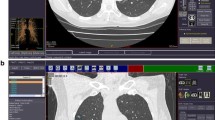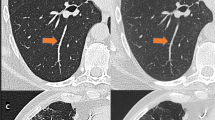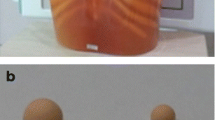Abstract
We evaluated the effect of the displayed image sizes on observers’ ability to detect nodular ground-glass opacity (n-GGO) on CT and investigated the optimal viewing size for soft-copy reading at CT screening for lung cancer. A total of 46 patients’ high-resolution computed tomography (HRCT) images (22 patients with one GGO; 24 without GGO) were displayed on a monochromatic liquid crystal display monitor at a resolution of 1,200 × 1,600. HRCT was presented on the screen with cine-mode display. We compared two viewing sizes (original size, i.e., the image displayed with a zoom factor of 1 in which each pixel value in the image is displayed as one pixel on the display: 13 cm × 13 cm; fit size, i.e., by zooming the captured image until it occupies the entire screen: 30 cm × 30 cm) in terms of radiologists’ performance for detecting n-GGO on HRCT and the viewing times required for soft-copy reading decisions. Observer performance was analyzed in terms of the receiver operating characteristic (ROC) curve. A statistically significant improvement was found with the original size in the average area-under-the-ROC curve values for the accuracy of diagnosis and the viewing times compared to the fit size (P < 0.05). The original size with cine-mode display leads to increased lung GGO detection at CT screening for lung cancer, and the reduced time spent performing the diagnosis offers cost savings.

Similar content being viewed by others

References
Li F, Sone S, Abe H, MacMahon H, Armato SG 3rd, Doi K. Lung cancers missed at low dose helical CT screening in a general population: comparison of clinical, histopathologic, and imaging findings. Radiology. 2002;225:673–83.
Nakata M, Saeki H, Takata I, Segawa Y, Mogami H, Mandai K, Eguchi K. Focal ground-glass opacity detected by low-dose helical CT. Chest. 2002;121:1464–7.
Schaefer CM, Prokop M, Oestmann JW, Wiesmann W, Haubitz B, Meschede A, et al. Impact of hard-copy size on observer performance in digital chest radiography. Radiology. 1992;184:77–81.
Fisher PD, Brauer GW. Impact of image size on effectiveness of digital imaging systems. J Digital Imaging. 1989;2:39–41.
Gur D, Klym AH, King JL, Maitz GS, Mello-Thoms C, Rockette HE, et al. The effect of image display size on observer performance an assessment of variance components. Acad Radiol. 2006;13:409–13.
Seltzer SE, Judy PF, Feldman U, Scarff L, Jacobson FL. Influence of CT image size and format on accuracy of lung nodule detection. Radiology. 1998;206:617–22.
Bessho Y, Yamaguchi M, Fujita H, Azuma M. Usefulness of reduced image display size in softcopy reading: evaluation of lung nodules in chest screening. Acad Radiol. 2009;16:940–6.
Yamaguchi M, Fujita H, Bessho Y, Inoue T, Asai Y, Murase K. Investigation of optimal display size for detecting ground-glass opacity on high resolution computed tomography using a new digital contrast-detail phantom. Eur J Radiol (Ireland). May 10 2010. (epub ahead of print) (record supplied by publisher)
International Commission on Radiological Protection. Managing patient dose in multi-detector computed tomography (MDCT). ICRP Publication 2007; 102.
Digital Imaging and Communications in Medicine (DICOM) part 14: Grayscale standard display function. Rosslyn, VA: National Electric Manufacturers Association. 1999; pp. 1–14.
Tanaka H. Guideline for quality assurance of medical imaging display monitors (In Japanese). Jpn J Radiol Technol. 2006;62:508–51.
Roe CA, Metz CE. The Dorfman–Berbaum–Metz method for statistical analysis of multi-reader, multi-modality ROC data: validation by computer simulation. Acad Radiol. 1997;4:298.
Krupinski EA, Maloney K, Bessen SC, Capp MP, Graham K, Hunt R, et al. Receiver operating characteristic evaluation of computer display of adult portable chest radiographs. Invest Radiol. 1994;29:147–9.
Niimi R, Shimamoto K, Sawaki A, Ishigaki T, Takahashi Y, Sugiyama N, et al. Eye-tracking device comparisons of three methods of magnetic resonance image series displays. J Digit Imaging. 1997;10:147–51.
Beard DV, Molina PL, Muller KE, Denelsbeck KM, Hemminger BM, Perry JR, et al. Interpretation time of serial chest CT examinations with stacked-metaphor workstation versus film alternator. Radiology. 1995;197:753–8.
Seltzer SE, Judy PF, Adams DF, Jacobson FL, Stark P, Kikinis R, et al. Spiral CT of the chest: comparison of cine and film-based viewing. Radiology. 1995;197:73–8.
Flynn MJ. Visual requirements for high-fidelity display. Advances in digital radiography: RSNA categorical course in diagnostic radiology physics 2003; pp. 103–7.
Hatada T. Eyeball movement and glasses. Jpn J Glasses Sci. 1977. http://www.kokuyo.co.jp/press/2005/09/433.html.
Wormanns D, Ludwig K, Beyer F, Heindel W, Diederich S. Detection of pulmonary nodules at multirow-detector CT: effectiveness of double reading to improve sensitivity at standard-dose and low-dose chest CT. Eur Radiol. 2005;15:14–22.
Fujita H, Yamaguchi M, Bessho Y, Uemura M, Abe S, Nakahira S, et al. Analysis of the display function on viewing monitors for the digital diagnostic imaging modality. Med. Imaging Inf. Sci. 2005;22:153–9. (in Japanese with English abstract)
Uemura M, Asai Y, Yamaguchi M, Fujita H, Shintani Y, Sanada S. Psychophysical evaluation of calibration curve for diagnostic LCD monitor. Radiat Med. 2006;24:653–8.
Goo JM, Choi JY, Im JG, Lee HJ, Chung MJ, Han D, et al. Effect of monitor luminance and ambient light on observer performance in soft-copy reading of digital chest radiographs. Radiology. 2004;232:762–6.
Yamaguchi M, Fujita H, Asai Y, Uemura M, Ookura Y, Matsumoto M, et al. Psychophysical analysis of monitor display functions affecting observer diagnostic performance of CT image on liquid crystal display monitors. Eur Radiol. 2005;15:2487–96.
Samei E, Badano A, Chakraborty D, Compton K, Cornelius C, Corrigan K, et al. Assessment of display performance for medical imaging systems: executive summary of AAPM TG18 report. Med Phys. 2005;32:1205–25.
Acknowledgments
The authors sincerely thank Drs Fukuda H, Higami T, Oonishi M, Ninoi T, Tsumura M, Daikokuya H, Sasada S, Awai K, Kobayashi S, and Tanaka S, for participating as reviewers and observers. This study was partly supported by a grant from the Japanese Ministry of Health, Labour and Welfare, no. H18-Shinko-011.
Author information
Authors and Affiliations
Corresponding author
About this article
Cite this article
Yamaguchi, M., Bessho, Y., Inoue, T. et al. Investigation of optimal viewing size for detecting nodular ground-glass opacity on high-resolution computed tomography with cine-mode display. Radiol Phys Technol 4, 13–18 (2011). https://doi.org/10.1007/s12194-010-0099-5
Received:
Revised:
Accepted:
Published:
Issue Date:
DOI: https://doi.org/10.1007/s12194-010-0099-5



